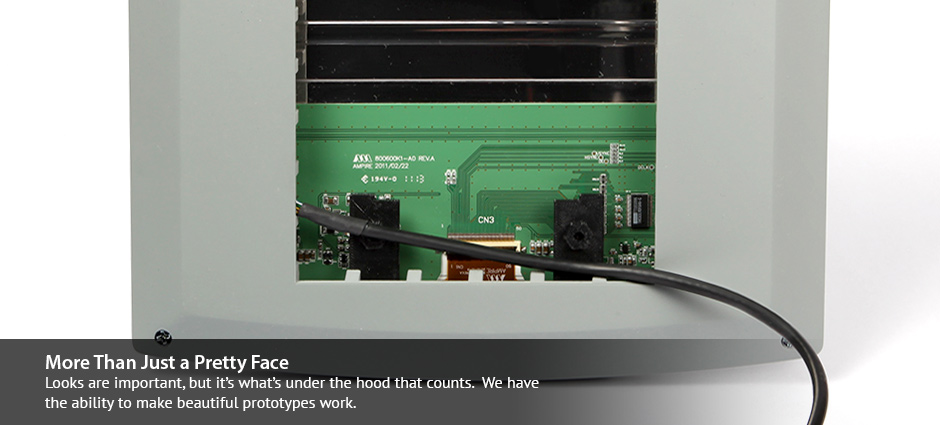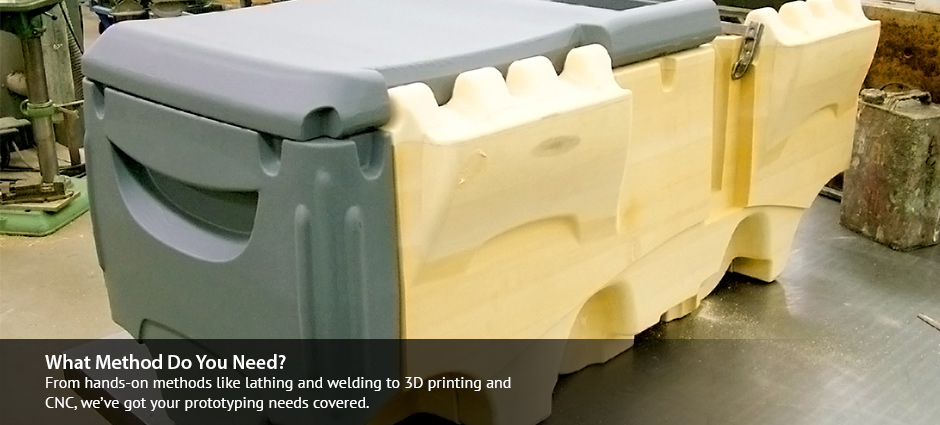Prototyping is one of the most important steps to ensure that a product design is right. It may sound simple, but getting it right is what we are intensely focused on. Any knowledge, skill, or process that helps achieve that, we pursue. And that is anything but simple.
We are unique in that we produce soft goods prototypes and hard goods prototypes. Combining both types of materials and processes offers unlimited creative options. Not many firms have our broad capability to marry textiles, films, plastics, fasteners and rigid parts.
The shape and function of a product can best be evaluated with something tangible to physically hold in your hands. How does it look and feel compared to the 3D CAD on a computer screen? It’s always an eye-opener when you have a prototype to try.
“It looks bigger (or smaller) than it did on the computer screen.”
“This grip needs to be larger here and smaller here.”
“It fits tighter (or looser) with that part. Let’s fix that.”
Prototyping has become more complex, but it has also become better and faster over the years. But as with anything, the devil is in the details – and we are always sweating over those. We have several decades of experience in making prototypes for many different markets, including medical, consumer, food service, sanitation, water treatment, plumbing, sports, wearables, soft goods, furniture, automotive, and more.

Selecting the Right Prototyping Method
So you’re ready and eager to test out your idea and create a prototype. Now what? Depending upon the needs the prototype must fulfill, there are a variety of different methods from which to choose. We evaluate different criteria such as fidelity, speed, materials, structural integrity and cost in order to choose a prototyping method that suits our client’s needs.
When it comes to high levels of intricate detail, three-dimensional printing techniques are often chosen such as FDM (fused deposition modeling), SLA (stereolithography apparatus) , SLS (selective laser sintering), and various forms of CNC (computer numerical control). Other prototyping methods include hand fabrication such as lathing, milling and carving as well as thermoforming and creating silicone or urethane molds. Rest assured that no matter what process your prototype may entail, we’ll find a way to get it done.

Bringing Your Idea to Life
When making high-impact, feature-defining decisions, having three-dimensional models and prototypes is invaluable. When performing research with end users, prototypes are often used by moderators and end users in focus groups, field (Beta) tests, and internal lab (Alpha) research.
A sketch or 3D CAD can quite often be misleading. When it comes to how a two-dimensional image translates into the real world, nothing compares to actually holding it in the palm of your hand. Although a product render might appear perfect on the computer screen, the actual handle might be a bit too big, the buttons slightly too small, or the angle of the display screen too low.
What it really takes to create a well-designed, functional product is to bring it to life through a prototype, assess all of the details, and then make the changes necessary to reach perfection. A decision that only relies on sight isn’t nearly as accurate as one made using the full range of senses.
Design it, make it, try it. Repeat as needed.

How Much Detail?
Another aspect to consider is the fidelity or refinement of the prototype. The amount of detail needed when evaluating a product design varies depending upon the client’s unique situation, ranging from cardboard and duct tape up to high quality prototypes indistinguishable from the final product.
Various stages of a project have different prototyping requirements, including:
- Works-Like / Breadboard / Proof of Concept – demonstrates the functionality of the product, from mechanics to its user interface, and can range from rough to refined.
- Looks Like – a tangible representation of a product’s aesthetic, ranging from foam models to painted parts.
- Ergonomic – tests the fit and feel of the product with humans (human factors)
- High Fidelity – looks and functions nearly identical to the final product.
Choosing the fidelity isn’t just about minimizing cost or time when more fidelity is not of benefit; it’s also about controlling the audience’s impression. A prototype that looks too finished early in the process may misrepresent how complete the design is and may immediately elicit rejection instead of suggestions for improvement. Conversely, a prototype that is not finished enough late in the process may have your audience focusing on missing details or the flaws of the prototyping process instead of the actual design.
We have the tools, resources, and experience to determine what type of prototype should be created and to what level of detail. There is more to prototyping than meets the eye.
Prototyping Services We Offer
Various Fidelity Models and Prototypes
- Functional Mockups
- Proof-of-Concept Prototypes
- Works-Like Models
- Looks-Like Models
- Finished, Functional Models
Rapid Prototyping (3D Printing)
- FDM (Fused Deposition Modeling)
- FFF (Fused Filament Fabrication)
- SLA ( Stereolithography Apparatus)
- 2-color printing
- Duplication printing
Other Techniques
- CNC Machining (Computer Numeric Control)
- Lathe-Turned Metal or Plastic
- Thermoforming Molds and Parts
- Injection Molding
- Urethane and Silicone Casting
- Metal Fabrication: forming, bending, punching
- Laser cut components
- Sheet Metal Parts
- Extrusions (plastic and metal)
- Welding, (TIG, MIG, ARC) Brazing, Soldering
- Ultrasonic Welding: metals for electronics
- Chemical and Heat Fusing Thermoplastics
- Wire and Tube Forming and welding complex shapes
- Soft Goods Fabrication (sewing, fabrics selection, joining)
- Fastening: Hook and Loop, snaps, zippers, buttons, magnets, custom attachments
- Die Cut Textile, Foam, Leather, and Plastic
- Heat-Sealed Flexible Film Containers
- Inflatables: Designs, Valves, Heat Sealing
- Electro-Mechanical Assemblies with motors, controls/logic, solenoids, gearing, sensors
- Fluid Systems (air and liquid) with valves, floats, seals, gaskets, control systems
Finishes
- Color-Match Painted Models
- Powder Coating
- Chrome, Zinc, Cadmium
- Anodize
- Oxide
- Media Blasting
- Vinyl Dip
- Raised Surface Texture with art
Other
- Electronics Breadboard Development
- Printed Circuit Boards (PCB) development
- Cabling Selection and Implementation
- LED Lighting
- Human Interface and User Controls
- Enclosures
- Full Color Packaging


